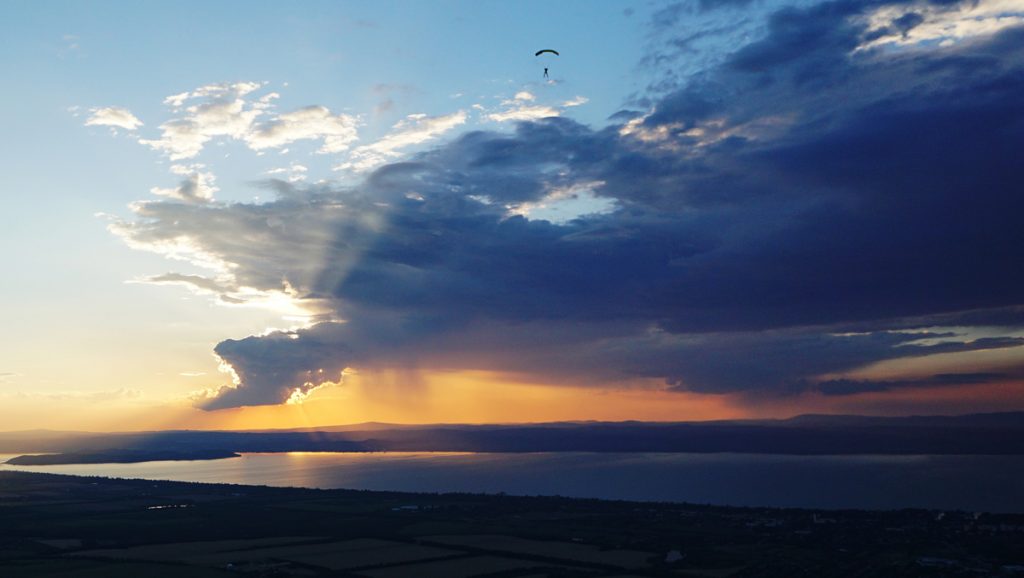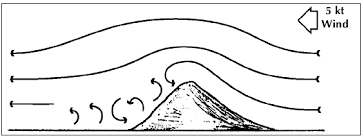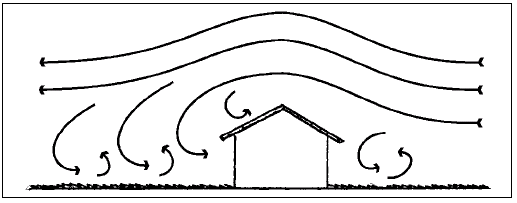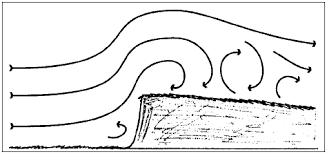It is easy to think of the weather as just being big. All too often as skydivers we assess things in very general terms without really worrying too much about the details – yet the most direct impact weather conditions can have on your skydiving can happen on an entirely personal level, affecting you and you alone while trying to successfully land a parachute.
I make no claim to being a canopy piloting coach and should you wish to further your skills in that area I recommend seeking out humans that offer professional structured courses in these matters. What follows is simple advice designed to encourage further learning by pointing out some of the more common weather phenomena that you will encounter above and around the dropzone.

Turbulence:
When wind hits something it bounces off in different directions which can cause difficulties for flying one’s parachute through if you are not prepared for it. Dropzones are hugely diverse in terms of layout and construction – from the humble Cessna using a strip of grass in the middle of nowhere to powerhouse operations that utilise a fleet of aircraft and resemble a municipal airport, however wherever you jump the same general rules about what to look for apply.
Below I have included some examples and a few shit-but-accurate pictures to demonstrate how wind behaves over and around common obstacles. By referring to these you can get some idea about how to be aware of potential hazards and avoid them when necessary.
Unstable Air – When the wind hits something big and flat like a hangar it spills out in lots of different directions at the same time. Depending on exactly where you are this could cause lift, sink, sideways motion or all of these in quick succession. Things can get really rough next to structures when it is windy – so use your brain, apply your training and be somewhere else.
Wind Shadow – A large enough object might create an area behind it which is clear of the turbulence and has no wind. Where you were previously crabbing like mad or going nowhere fast – if you enter a wind shadow you might suddenly find you have a surge in ground speed and have to adjust where you though you were going to land. Be very ready for more turbulence.
Bottleneck – This is when wind speeds up rapidly to squeeze a large volume of air in a small gap between two objects. This can also be compounded by the other problems created by wind trying to get around things such as an increase in instability.




Thermal Activity:
Thermal activity is generated by the sun heating the air – warm air expands pushing outwards and cold air contracts drawing inwards, causing wind. The most common experience most of us initially have with this effect is via some toothy weather person gesticulating at region-wide areas of a greenscreen map on the telly and describing which way the wind will most likely be pointing. However – thermals gather and release on a much, much smaller scale than this and can be localised enough to effect your flight while navigating a canopy.
Things to look for are items and areas that are good at causing lift by either reflecting heat such as tarmac (runway/carpark/roads) and metal (hangars), or storing heat such as bodies of water. A small amount of thermal activity is not going to cause serious issues with your flight pattern or your canopy’s performance but some sudden lift or sink when you are not expecting it can mean the difference between landing in your intended spot and somewhere else. In some places thermals can be surprisingly violent and threaten your safety – ask anyone who has tussled with an Arizona dust devil that sprang as if from nowhere on an otherwise perfect skydiving day.

Behaviour:
So what do you do when things get more challenging? Dropzones operate under official limits for jumping and will often have their own rules in place for particular conditions. For example, you might be required to land in a different area if the wind is coming from a certain direction, or you might have to stop jumping sooner than you were planning due to a particular quirk in the local terrain. Learn these special circumstances and understand why they exist – you never know when such knowledge will help you make a good decision somewhere unfamiliar when the pressure is on.
Despite established parameters the person responsible for your safety is you. If you decide keep jumping as conditions get ‘interesting’ it is only sensible to modify your behaviour for increased safety:
- If it is getting super windy then use any available space and land clear of hazards and other canopies. Walking a long way back to the hangar is better than crawling even the shortest distance if you have to do it into the back of an ambulance.
- Landing crosswind or downwind into clear space and sliding across the grass like a goose landing on a frozen pond is better than turning low into the wind and flying face-first into the ground.
- If the wind is actively changing direction as you look at the indicators then follow the rules and land the way the arrow is pointing. Again – it is safer to all land in the same direction regardless of which way the wind is going than all try to face into it as it moves around and risk a collision.
- Watch other people land. If the wind is getting up then maybe have a break and watch a load or two. Assess everyone from Captain Swoopypants all the way through to the tandems and those with lower experience.
Try to develop a habitual curiosity about what is going on at the particular spot you like to skydive. Many noteworthy incidents in our sport can be traced back to awareness of small things that could easily be avoided with a little learning.
